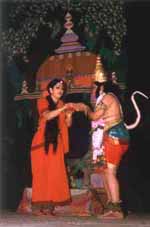Jagadaanandakaaraka By Shobha Naidu

Jagadaanandakaaraka By Shobha Naidu is an event that took place on 28-Nov-2000 in Hyderabad.
-
Venue
-
Date/Time
-
Type
-
Price
-
Tickets At
-
Add New Field:
REVIEW FOR JAGADAANANDAKAARAKA BY SHOBHA NAIDU
"Jagadaanandakaraka" happens again. Only, this time the small stage of the Keyes High School had its dancers, musicians, props, sets and lights jostling for space! And the audience had to spend most of its time watching this shoving process and not the play itself.
The play had the usual Shobha Naidu effects - dramatizations, of good persons, of bad characters, and of the Almighty who protects all, songs and dance enhancing the mood of the blushing heroine or the valorous hero, and so on. This play is based on the various songs of Thyagaraja to depict the whole Ramayana, with connecting phrases picked from the writings of Molla (Molla Ramayanam). As the dancers entered and exited, backdrops (painted curtains) rose and fell, music poured and paused, and the whole narration was akin to a panting race!
The narration follows the Ramayana, and if you know it, you can skip this paragraph. The birth of Rama and his brothers follows the 'Putrakamesti Yagnam', and the kids grow up learning the martial arts. They defeat the demons in the jungle at the 'Vishwamitra Yagnam', and Rama weds Sita after the 'Swayamvaram' where many an aspiring youth including Ravana fails to lift Siva's bow to win her hand.
The couple, along with Lakshmana, then goes on exile to the jungles, where Ravana abducts Sita and slays the giant bird Jatayu on his way to Lanka. With the collaboration of the monkey military, Rama conquers the ten-headed king of Lanka, and he and Sita, along with a host of characters, pose for the 'Pattabhishekam', with flowers showering from above. And with the songs of 'Mangala Harathi' and blessings for all, the play came to an end.
Mahankali Mohan provided the rhythmic support with his nattuvangam, and percussionist P R C Sarma, flutist Ananta Krishna, violinist Sai Kumar, ghatam artist Om Prakash, and vocalists Kanna Rao and Sarada comprised the orchestral support from the wings.
USER REVIEWS FOR JAGADAANANDAKAARAKA BY SHOBHA NAIDU
Be the first to comment on Jagadaanandakaaraka By Shobha Naidu! Just use the simple form below.
LEAVE A COMMENT
fullhyd.com has 700,000+ monthly visits. Tell Hyderabad what you feel about Jagadaanandakaaraka By Shobha Naidu!
MORE EVENTS IN THIS PERIOD
ALL EVENT CATEGORIES
SEARCH EVENTS
Dissatisfied with the results? Report a problem or error, or add a listing.
ADVERTISEMENT
SHOUTBOX!
{{ todo.summary }}... expand »
{{ todo.text }}
« collapse
First | Prev |
1 2 3
{{current_page-1}} {{current_page}} {{current_page+1}}
{{last_page-2}} {{last_page-1}} {{last_page}}
| Next | Last
{{todos[0].name}}
{{todos[0].text}}
ADVERTISEMENT
This page was tagged for
Yagnam .HUED .video
Keyes Girls High School events
November 2000 events
hyderabad arts
hyderabad theatre / comedy / dance